I’ve been writing about some of Italy’s most spectacular frames, including the Basilica San Marco in Venice and Giotto’s Tower in Florence, and great lessons their stones still teach about the place of art and the unity of the arts—two fundamental concerns of the frame-maker, and of the Arts and Crafts Movement. The Palazzo Publico in Siena, a third stop on our trip this summer following in John Ruskin’s footsteps through northern Italy, is another great frame, with its own great lessons written in stone—and painted in plaster.
As he did in the first two cities, Ruskin read in Siena’s Gothic buildings understandings about the fundamental nature of civilization, its laws and its arts—eternal truths deeply at odds with the industrial age in Britain. Siena’s 14th century town council chamber, La Sale de Pace, or Room of Peace, frames an extraordinary set of frescoes, painted by Ambrogio Lorenzetti in 1338-9, in which Ruskin recognized a profound vision and understanding of good and bad government, and their effects on the life of a people. The frescoes are the basis of a fascinating discussion by Ruskin, in his book A Joy Forever, about how, in his allegory, Lorenzetti doesn’t allow the virtues that guide good government—Faith, Hope, and Charity above all—to be idle, but puts them to work! Work, which is the theme at the heart of Ruskin’s thought, is indeed the underlying theme of the vision of society Ruskin so admired in Lorenzetti’s frescoes.
We tend to trivialize the Arts and Crafts Movement, the seeds of which were planted by Ruskin, by reducing it to being largely concerned with stuff. The truth is, the stuff was only important as a direct expression of the life and labor that produced it. The Arts and Crafts was truly a social movement. Many have characterized its leanings as utopian and, therefore, unobtainable. But its visions endure nevertheless to challenge our complacency, our lack of social imagination, our denigration of labor, and our capacity and will to virtuous civic practices. In this respect medieval frescoes such as Lorenzetti’s inspired not only Ruskin but William Morris, who also praised the didactic and visionary role of medieval art, and railed against modern work’s loss of vision. He once wrote,
Civilization has reduced the workman to such a skinny and pitiful existence, that he scarcely knows how to frame a desire for any life much better than that which he now endures perforce. It is the province of art to set the true ideal of a full and reasonable life before him, a life to which the perception and creation of beauty, the enjoyment of real pleasure that is, shall be felt to be as necessary to man as his daily bread.
It seems to me that Lorenzetti was a workman who enjoyed a healthy existence that afforded him plenty of thought about what comprised a good life—a truly civilized life characterized by beautiful work. He was an artist who was afforded by his republican civic patrons the freedom of imagination and intellect to frame such a desire. It’s telling—the enduring frescoes tell us in no uncertain terms—that such dreams of a true republic and commonwealth were not only deemed by Siena’s leaders worthy of spectacular framing in a beautifully built and decorated room but were deemed worthy of framing them in the solemn deliberations convened in that room.
These were people who took their ideals seriously enough that they were determined to live by them, and to have them always before the people as a visible standard against which they would be judged.
As did the bas reliefs on Giotto’s Tower in Florence, Lorenzetti’s frescoes in Siena offer wonderful evidence, in Italy’s medieval republics, of the noble place and standing of the handcrafts and humbler arts. They are always given their due regard from “fine” artists who clearly make no effort to separate themselves from the humbler craftsmen, as they would from the Renaissance onward. Frescoes prove Ruskin’s argument for the unity of art that prevailed in the middle ages, an argument he directed not least of all to his Victorian contemporaries who insisted on treating painting as a separate and isolated, superior art having nothing to do with the “merely” decorative arts that comprise architecture. Lorenzetti clearly had no compunctions about the constraints of painting the walls of a room. Such compunctions are a modern problem—one that Ruskin railed against. The modern painter is not a greater artist because he’s given up the frankly more decorative art of mural painting for the independence of easel painting. “Get rid… at once of any idea of Decorative art being a degraded or a separate kind of art,” Ruskin wrote.
Its nature or essence is simply its being fitted for a definite place; and, in that place, forming part of a great and harmonious whole, in companionship with other art; and so far from this being a degradation to it—so far from Decorative art being inferior to other art because it is fixed to a spot—on the whole it may be considered as rather a piece of degradation that it should be portable. Portable art—independent of all place—is for the most part ignoble art.
Passionate as he was about the unity of the arts, we have to pardon Ruskin’s hyperbole. (That he did make allowances is evident from the fact that his six-volume Modern Painters, was, after all, devoted to a painter of portable art, JMW Turner.) If not absolute, though, history demonstrates a strong tendency of people to give their greatest ideals permanent place and form in that most permanent, most public and collaborative art, architecture. Permanently embedded and integrated expressions are not likely to be devoted to fleeting whims or ephemeral oddities of purely personal self-expression. Instead, their lasting nature befits enduring, timeless and deeply rooted values and aspirations of the whole citizenry.
Ruskin identifies in Gothic architecture the ancient understanding of work—human labor; the arts of civilization—that we find for example in the Book of Sirach, in the Apocrypha, which speaks of craftsmen who “each becometh wise in his own work.” “Without them,” it says, “shall no city be inhabited.” Though they are not rulers or legislators, judges or clergymen, still “they shall maintain the fabric of the world; and in the handiwork of their craft is their prayer.”
All the arts, no matter how utilitarian or humble, are seen as involving and embodying significance, importance and meaning for the whole community—the “fabric of the world”, and the social fabric of the towns, like Siena, that comprise it. Lorenzetti’s Sale de Pace frescoes exemplify this pre-modern worldview beautifully. Reading the lessons of the Allegory of Good Government from left to right, they begin with the source of benign rule in the figure of Justice. At the feet of the figure of Justice sits another figure cradling in her lap an emblem of an ideal at the root of good government—no abstract, complex, obscure or obtuse sign understood only by scholars and philosophers, but a humble carpenter’s or cabinetmaker’s hand plane. On the plane is inscribed “Concordia,” or harmony. The type of long plane the figure is holding is called a jointer plane, and is a primary tool of the joiner. It’s used to smooth and level, as well as “joint” the edges of boards that are to be glued up edge-to-edge. The word harmony derives from the Latin harmonia—joining, or concord; and from the Greek harmos, meaning joint. According to the great Anglo-Indian art historian, Ananda Coomaraswamy (1877-1947), “‘harmony’ was first of all a carpenter’s word meaning ‘joinery,’ and…it was inevitable, equally in the Greek and the Indian traditions that the Father and the Son should have been ‘carpenters’…” Thus the joiner’s hand plane represents the ideal of civic harmony—society well-joined. There could hardly be a better symbol of the relation of work—the dignity and essential role of ordinary labor—to the great problem of social justice.
But the theme of the joining of society, of a healthy social fabric, is only begun. Ropes from the figures of Mercy and Punishment that flank Justice pass through Harmony’s hand to a procession of noblemen, each grasping the rope, and so are joined to it and joined together, as they head toward the large ruling figure representing the Common Good, beside whom sit the virtues. The ends of the ropes are held by the Common Good, thus connecting him to Justice and the people.
.
The adjacent wall to the right of the allegory of Good Government depicts the effects of such policy; and in Lorenzetti’s view, the place of the ordinary artisan in Siena is—everywhere. The arts thrive in a healthy town of contented, industrious folk joined in cooperative effort, happy commerce and mutual provision. We can see the shops of cobblers, potters, metalsmiths. There’s a teacher before his class of attentive students. Men (and, according to at least one scholar, a woman) build in the background of a city beautifully composed of diverse houses, towers and shops, civic buildings and a church (Siena’s great cathedral—placed well into the background!). And in the foreground is a wedding procession followed by a group of beautifully dressed women, hands joined in festive song and dance. It’s an example of the once commonplace collective joy, rooted in Dionysus and most commonly practiced in carnival, that Barbara Ehrenreich writes about in her wonderful history Dancing in the Streets.
But the town occupies just half this fresco. The city wall divides the fresco down the middle, with the right half of the whole composition devoted to agriculture. There, busy farmers tend healthy fields and livestock. A road carries traffic to and from the city; urban and rural life co-exist in happy mutuality. With the greater good successfully presiding, the angel of Security hovers over the town and surrounding countryside.
Opposite this wall, to the left of the Allegory of Good Government, Lorenzetti juxtaposes for us the Allegory and Effects of Bad Government. (Water damage has destroyed much of this mural. The Sienese say this means bad government doesn’t last.) Tyranny rules, aided by the vices, and Justice lies bound at his feet. Life under such government, the painter shows us, is not good. Discord and destruction characterize city and countryside. Above this land looms the angel of Fear.
In the debate about rebuilding Britain’s House of Commons after it was bombed by the angels of fear dispatched by the German Nazis, Winston Churchill said, “We shape our buildings, and afterwards our buildings shape us.” It’s something that was understood in 14th century Siena, where they constructed La Sale de Pace to shape the ideals of the Council of Nine and guide them in their duties. Lorenzetti surrounded them with reminders of their civic obligations, and of how a city should be governed, of how well we all might live if we govern ourselves well—or how terrible life might be if we fail to do so.
Among the abundant lessons housed in Siena’s La Sale de Pace—including the roots and bases of civic harmony, the unity of the arts—lies a profound lesson about framing pictures. While our ideals aren’t always as lofty as Lorenzetti’s, nor as permanent as his frescoes, the frames we provide for them should nevertheless offer solidity and enduring place as part of the architecture of our homes and the settings for our daily lives. The images we choose to hang in our homes often express and, as Morris said, frame our desire for a “full and reasonable life.” When we frame pictures, we frame ideals, and those ideals then frame, and shape, us.
Learn more about the Lorenzetti murals…
Read “Framing Paradise in the Stones of Venice”…
Read “What Ruskin Saw Framed in the Stones of Florence”…
- Ambrogio Lorenzetti’s murals
- “Allegory of Good Government”
- The figure Justice, with Concordia, or Harmony, at her feet
- Detail of Concordia holding a joiner’s handplane
- “Effects of Good Government”—the town
- The Effects of Good Government
- “Allegory of Bad Government”
- “Allegory of Bad Government”
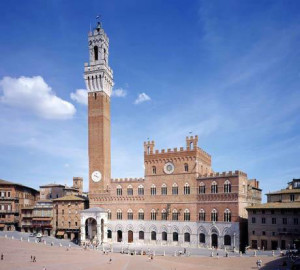
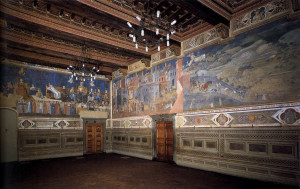
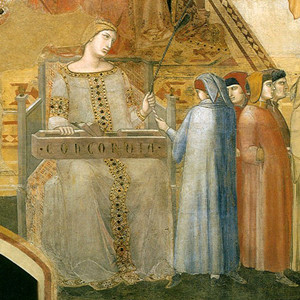
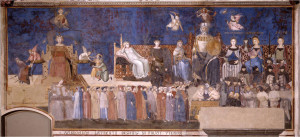
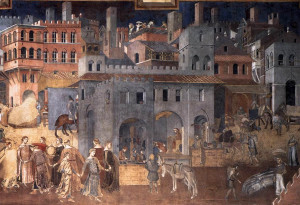
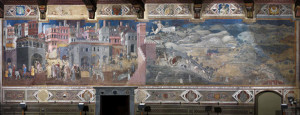


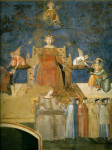
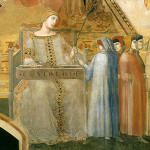
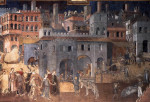



His uncle, Jacopo di Domenico di Luca del Borra Gamberelli may have given him his first lessons in stonemasonry. By 1420, Bernardo was certainly down in Florence and apprenticed to one of that city’s better-known sculptors, perhaps Nanni di Bartolo, called “il Rosso (the redhead)”. Such a relationship might explain the nickname of “Rossellino (the little redhead) given to Bernardo and applied to his brothers, Antonio, Domenico, and Giovanni. Curiously, there is no record of Bernardo’s entry into Florence’s Guild of Stone and Woodworkers, although matriculation information exists for his brothers.